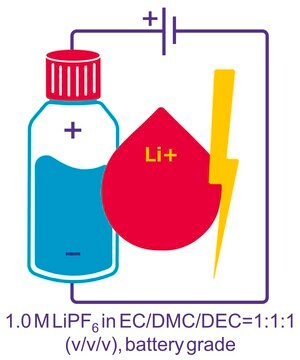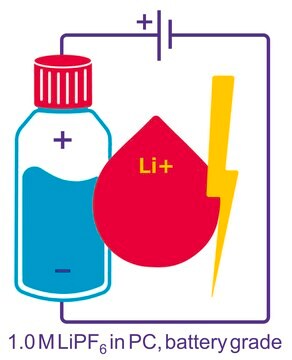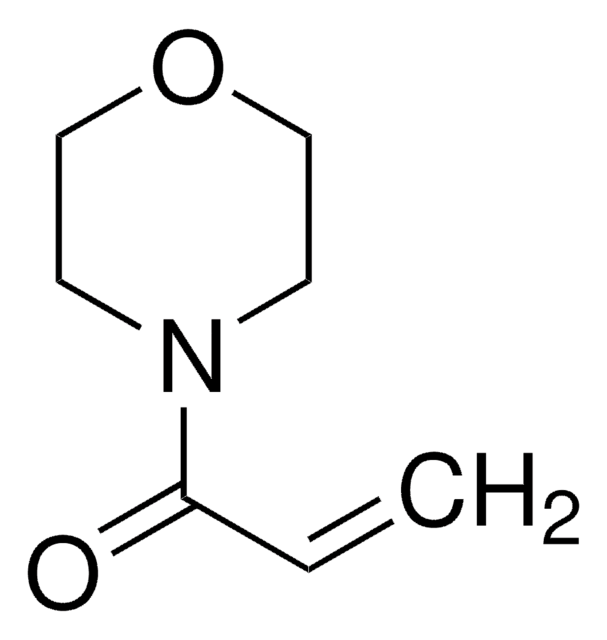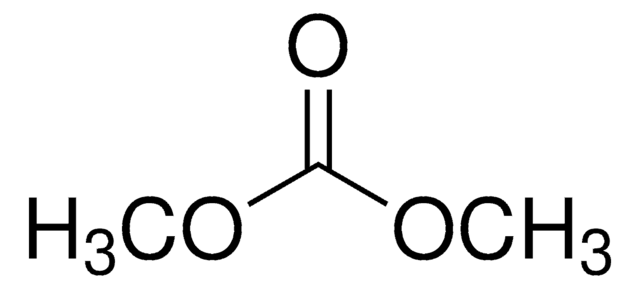746711
Lithium hexafluorophosphate solution
in ethylene carbonate and dimethyl carbonate, 1.0 M LiPF6 in EC/DMC=50/50 (v/v), battery grade
Sinónimos:
1.0 M LiPF6 EC/DMC
About This Item
Productos recomendados
grade
battery grade
Quality Level
form
solution
greener alternative product characteristics
Design for Energy Efficiency
Learn more about the Principles of Green Chemistry.
sustainability
Greener Alternative Product
concentration
(1.0 M LiPF6 in EC/DMC)
impurities
<15 ppm H2O
<50 ppm HF
color
APHA: <50
bp
90 °C
density
1.30 g/mL at 25 °C (lit.)
anion traces
chloride (Cl-): ≤1 ppm
sulfate (SO42-): ≤2 ppm
cation traces
Ca: ≤1 ppm
Fe: ≤1 ppm
K: ≤1 ppm
Na: ≤1 ppm
Pb: ≤1 ppm
application(s)
battery manufacturing
greener alternative category
, Enabling
SMILES string
F[P-](F)(F)(F)(F)F.[Li+]
InChI
1S/F6P.Li/c1-7(2,3,4,5)6;/q-1;+1
InChI key
AXPLOJNSKRXQPA-UHFFFAOYSA-N
¿Está buscando productos similares? Visita Guía de comparación de productos
General description
Application
Liquid electrolyte solutions play a key role in lithium ion batteries (LIB) acting as a carrier of lithium ions between the cathode and anode. High-purity and battery-grade electrolyte solutions are thus crucial for lithium ion battery performance. The most common LIB electrolytes are derived from solutions of lithium salt, such as LiPF6 in non-aqueous solvents, example alkyl carbonates or solvent blend. The choice of the electrolyte solution is dependent on both the operating conditions like temperature and the nature of the electrode material in the LIB. The performance of the electrolyte solutions can be further modified with appropriate additives.
Other Notes
- Do not use with glass equipment
- All work should be done very quickly under dry air to prevent electrolytes from water uptake and solvent vaporization.
Legal Information
Related product
signalword
Danger
Hazard Classifications
Acute Tox. 4 Oral - Eye Irrit. 2 - Flam. Liq. 3 - Skin Irrit. 2 - STOT RE 1 Inhalation - STOT RE 2 Oral
target_organs
Bone,Teeth, Kidney
Storage Class
3 - Flammable liquids
wgk_germany
WGK 2
flash_point_f
77.0 °F
flash_point_c
25 °C
Elija entre una de las versiones más recientes:
¿Ya tiene este producto?
Encuentre la documentación para los productos que ha comprado recientemente en la Biblioteca de documentos.
Los clientes también vieron
Artículos
Dr. Sun reviews the recent advances in solid-state rechargeable batteries and cover the fundamentals of solid electrolytes in solid-state batteries, the theory of ion conduction, and the structures and electrochemical processes of solid-state Li batteries.
Lithium-ion batteries (LIBs) have been widely adopted as the most promising portable energy source in electronic devices because of their high working voltage, high energy density, and good cyclic performance.
The critical technical challenges associated with the commercialization of electric vehicle batteries include cost, performance, abuse tolerance, and lifespan.
Due to the adverse impact of the continued use of fossil fuels on the earth’s environment and climate, researchers have been asked to develop new approaches for producing power using renewable sources like wind and solar energy
Nuestro equipo de científicos tiene experiencia en todas las áreas de investigación: Ciencias de la vida, Ciencia de los materiales, Síntesis química, Cromatografía, Analítica y muchas otras.
Póngase en contacto con el Servicio técnico











